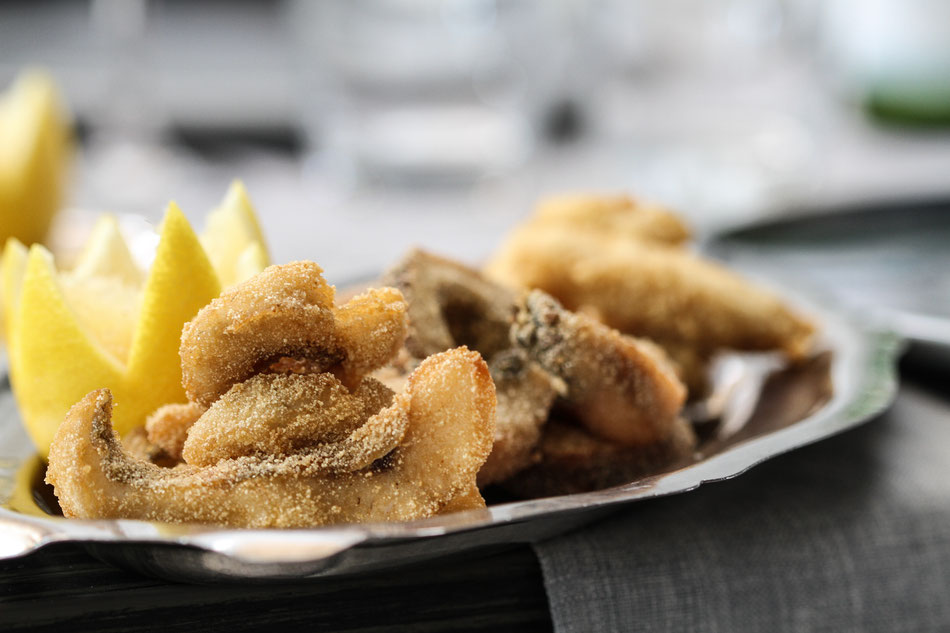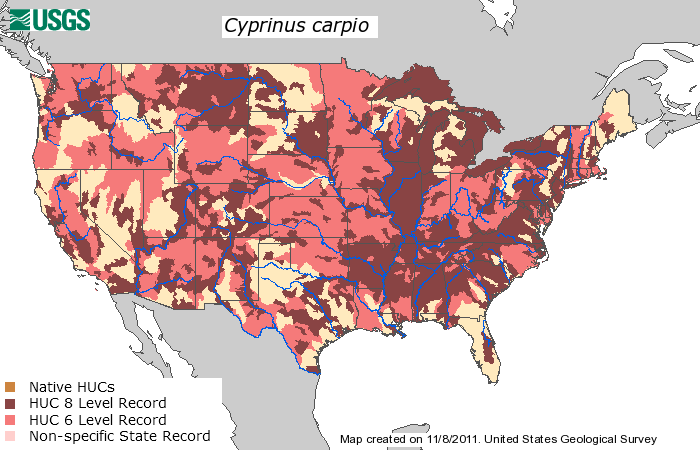Invasive range: Cosmopolitan, including throughout the US and on every continent except Antarctica.
Habitat: In rivers and lakes, carp prefer shallow, sluggish, warm, and well-vegetated waters. They also thrive in bayous, reservoirs, farm ponds, and sewage lagoons. (You might want to skip the lagoons, if looking for a filet or lucky scale.)
Description: Body is robust, deep and thick, arched toward the dorsal fin. Varies in color from gray to bronze. Two fleshy barbels project downward on each side of the jaw. The dorsal fin is armed with a serrated spiny ray, resembling the plume on a Roman soldier’s helmet.
For a bottom-feeder, what is the good life? The common carp isn’t very demanding: any body of water that’s sluggish and murky will do. One catching sewage or farm runoff is especially nice. Clear, running water: no thanks. As far as food goes, almost anything is fine: plant waste, water weeds, plankton, freshwater shrimp, snails, or fish eggs. Carp are messy eaters, stirring up mud, uprooting plants––and there, in a ripple effect, from zooplankton to insects to fish to birds, goes biodiversity in a body of water. As the silt takes its time to resettle, it can disturb native fish spawning and make it hard for wading and diving birds to see their prey underwater. It can reduce the growth of aquatic plants and increase the biomass of algae.
Introduction to North America
This invader is native to the Caspian and Aral Seas. How did it arrive? By 1870, native North American fish stocks had been so overharvested by white settlers––and more settlers were pouring in all the time needing to be fed––that the U.S. Fish Commission was directed to address the issue. Three hundred and forty-five common carp were brought over from Bremen, Germany, and propagated by the commission. Why was the common carp chosen over native fish? Its ease of reproduction. Its adaptability to a range of habitats. Its being a delicacy in Eastern Europe and Russia. With assistance from state fish commissions, the fish were released across the country, sometimes into open water from railroad tank cars at bridge crossings.
In 1882, one of the carp’s proponents, Charles Smiley, predicted that the carp, and the cultivation of fish in general, would be the future of U.S. agriculture–with fish being raised like sheep, poultry, or grain. He was right about aquaculture, though the carp survives in many places without any help from farmers.
Active stocking was discontinued in 1897 because by then not only had carp been distributed to almost every state and territory but they were so well established that calls for eradication were already starting to be heard from state fish commissioners. A century has come and gone since them, and the carp are still here, and thriving. Some fishermen have suggested that the “Age of Bronze,” as the current great days of bass fishing have been dubbed, may be followed by the “Age of Carp,” given the strength of their and the Asian carps’ numbers.
At Home in Poland
In Poland, Wigilia, the traditional Christmas eve meal is observed as a Black Fast in the Eastern Orthodox rite, meaning that one abstains from eating red meat on this day. Wigilia includes Borscht (beetroot soup) with Uszka (ravioli). Traditionally, carp provides the main dish, whether fried, baked, poached in aspic, etc. A live carp is purchased the day before Christmas eve and kept in water to allow time for the fish to purge itself of the river where it was caught. Often this meant that a fair-size carp was kept in the bathtub, to the delight of the children in the family.
Some Poles keep one or two scales from the Christmas Eve carp in their wallet to bring good fortune in the coming year.
Catching Carp
Many anglers are partial to doughballs and cooked corn. In-Fisherman reviews the many baits here. Earthworms are invasive to many parts of the U.S., so make an excellent ETI choice. Just don’t release them when you’re done.
Sundgau Fried Carp
Fried carp is a celebrated dish in the Sundgau in the southern Alsace region of France, where monks have been raising carp since medieval times. This recipe is an adaptation of the simple and delicious dish that has been served here for centuries. A centerpiece of the local cuisine, fried carpalso makes a great dish in the New World.
Adapted from French Country Cooking: Authentic Recipes from Every Region, by Françoise Branget.
Serves 4
3 pounds of center-cut carp filets
1-2 cups white wine
pepper and salt
½ cup fine semolina
canola oil for frying
Expect to get about 1 pound center fillet per 3-pound fish, so scale the recipe accordingly.
Cut uniform filet sections about ½ inch thick.
Put filets in a flat-bottom dish. Pour in wine to cover and marinate for 20 minutes
Remove fish and drain. Season with salt and pepper. Dredge filets through semolina.
In a deep fryer or deep pan, heat at least 2 inches of oil to about 330F. Fry until golden outside, for about 4 or 5 minutes. Remove the filets and allow them to cool for about 10 minutes, or until ready to serve the meal.
Increase oil heat to 375F and fry carp a second time for about 3 to 4 minutes.
Carp is traditionally served with steamed potatoes or frites, a green salad, lemon wedges, and mayonnaise, and an Alsatian white wine such as pinot blanc. The fish is typically eaten with hands, not utensils.
Baked Carp in Sour Cream with Wild Mushrooms, Hungarian Style
Courtesy of the late George Lang, owner, Café des Artistes, New York
Serves 8 to 10
5 lbs cleaned and scaled carp
salt and pepper
4 T unsalted butter, plus more for the parchment paper
1/2 lb wild mushrooms, sliced
1 med onion, chopped fine
1 T chopped flat-leaf parsley
1 c dry white wine
1 c sour cream
1/4 c heavy cream
1 T flour
buttered steamed new potatoes
Preheat oven to 375.
Cut the cleaned carp into serving pieces, and sprinkle with salt and pepper. Place the pieces in a baking pan in one layer and dot with the butter.
Sprinkle mushrooms, onion, and parsley over carp. Pour wine over fish and cover with buttered parchment paper. Bake for 15 minutes, or more, until cooked through.
Mix sour cream, heavy cream, and flour in small saucepan and bring to simmer. When carp is about half done, pour sour cream mixture over it and complete cooking.
Adjust salt to taste, and serve with buttered steamed new potatoes.
Christmas Carp
Don’t miss Neil B’s effort to re-create the great Jane Grigson’s eighteenth-century Christmas Eve carp recipe.





























{ 8 comments… read them below or add one }
I have smoked cleaned and skinned whole carp successfully – the best carp are caught in clean water streams – if there are also trout in the stream, then the carp will taste fine.
It would be easier if one could smoke the carp without scaling/skinning it – perhaps I’ll try that with the next one I catch.
I just found out about this traditional Iraqi carp dish yesterday: https://blog.arousingappetites.com/masgouf-iraqi-turmeric-tamarind-marinated-fish-tomato-curry/
Hello,
There are Common Carp that spawn regularly in a pond beside my school. The pond is very small and unclean. Will storing the caught fish in clean water for a time really help purge it of “river” taste, like the article says?
Best,
Dylan
You should always beware of harvesting anything from polluted waters. If the pond is dirty and polluted, we suggest avoiding eating anything from the pond. Check with local fish and game wardens to be sure
I see common carp in fish tanks for sale all the time. Although, I usually buy saba (mackerel) or sanma (saury fish) whole for my dinners, the Chinese usually pick one from the tank and have it filleted by the fish monger on the spot. Japanese people traditionally had carp as sushi.
We use to pickle them in vinegar let set 6 month’s after pressure canning. Also. You can pressure cook them so bones are soft then make patties like salmon
There is a wonderful Chinese dish served in many Chinese restaurants called Crispy Fish. It is traditionally made with “yellow fish” that we know as carp. It is very good!
Thanks, Judy. Let us know if you come across a recipe.